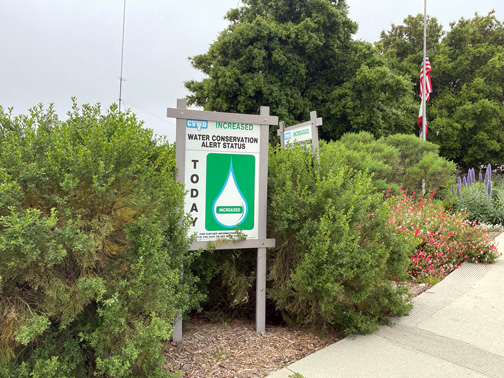
Photo by Mary O’KEEFE
By Lucian KUGLER
Just months ago, California was in a prolonged drought, which led to significant water shortages, wildfires and economic losses. Then came an unprecedented winter of rain. This led some to believe that the drought is over; however, experts ultimately decided it’s premature to declare an end to the drought. California’s water supply relies on various factors, including snowpack in the mountains and reservoir levels, which have seen a massive improvement but not to a sustainable level.
“With the increased rainfall and snowpack, there has been improvement in State Water Project (SWP) supplies, which has allowed most local agencies including CVWD to reduce conservation requirements to customers,” reads a statement released by Crescenta Valley Water District.
Despite California’s declining population (according to Calmatters), its water supply is still strained. The state’s agricultural industry accounts for a significant portion of the state’s water usage, and it must find ways to reduce water consumption and increase efficiency. Sustainable water management practices and water conservation efforts are essential to ensure a reliable water supply for future generations.
Climate change has increased the frequency and intensity of extreme weather events such as droughts and floods. California has experienced cyclical droughts in the past, and it is possible that the recent winter’s precipitation may be a single exceptional year of rain … and snow. Therefore, taking a long-term view is necessary. The state must consider the impact of the drought on California’s environment and wildlife and work to mitigate the long-term effects of the drought.
“Though conditions have improved on the State Water Project, Southern California is seeing a very different story on our other source of imported water, the Colorado River,” continued the CVWD statement. “More than two decades of drought and severely dry conditions have caused reservoirs to drop to historic low levels, jeopardizing water supply and power generation that the Southwest relies on. Therefore, we need to encourage customers to remain diligent in using water efficiently.”
The recent winter’s precipitation has not been evenly distributed throughout the state. While some regions received substantial rainfall and snowfall, other areas have not. It is essential to take a regional approach when assessing the state’s water supply levels. California is a vast and diverse state with varying water supply needs, and a regional approach can help policymakers make more informed decisions.
The prolonged drought has caused significant damage to California’s ecosystems, including the loss of vegetation, wildlife habitat and increased wildfire risk. While the recent rainfall has been beneficial and brought the area’s drought level down to moderate, it may take longer for the state’s ecosystems to fully recover from the drought’s impact.
California has taken various steps to address the drought, such as implementing regulations to reduce water usage in the agricultural sector and encouraging homeowners to replace their lawns with drought-tolerant landscaping. However, the state must continue to prioritize sustainable water management practices and water conservation efforts. The state’s Sustainable Groundwater Management Act requires local agencies to develop plans to manage groundwater resources sustainably.
While the recent rainfall has been historically beneficial the state has decided it is premature to declare an end to California’s drought.
